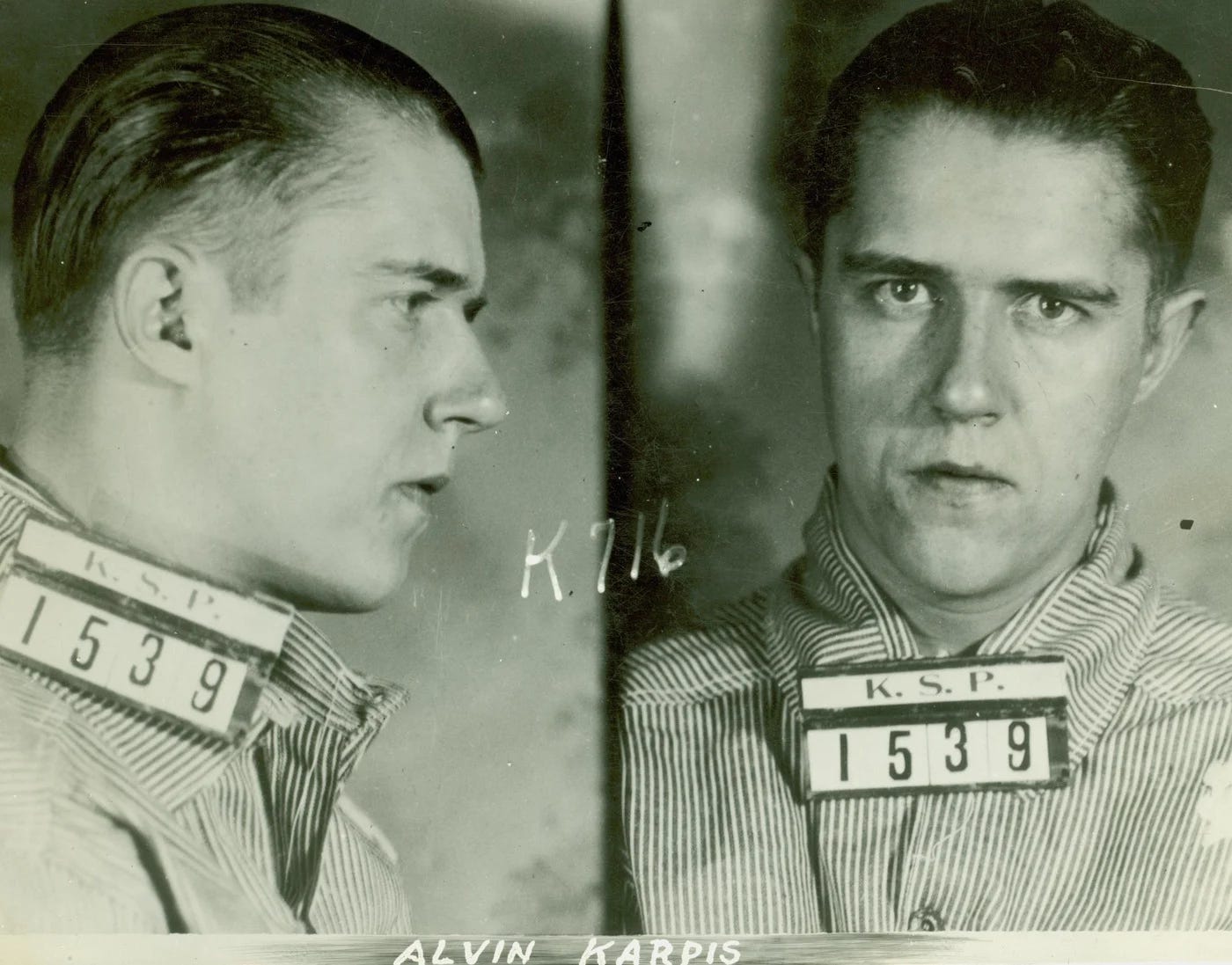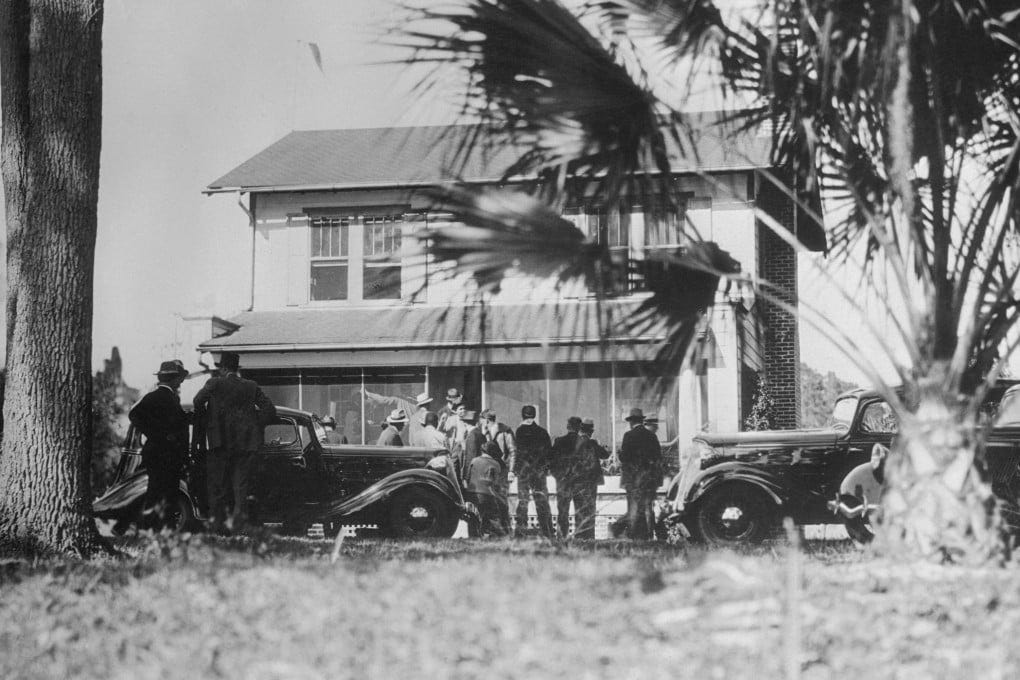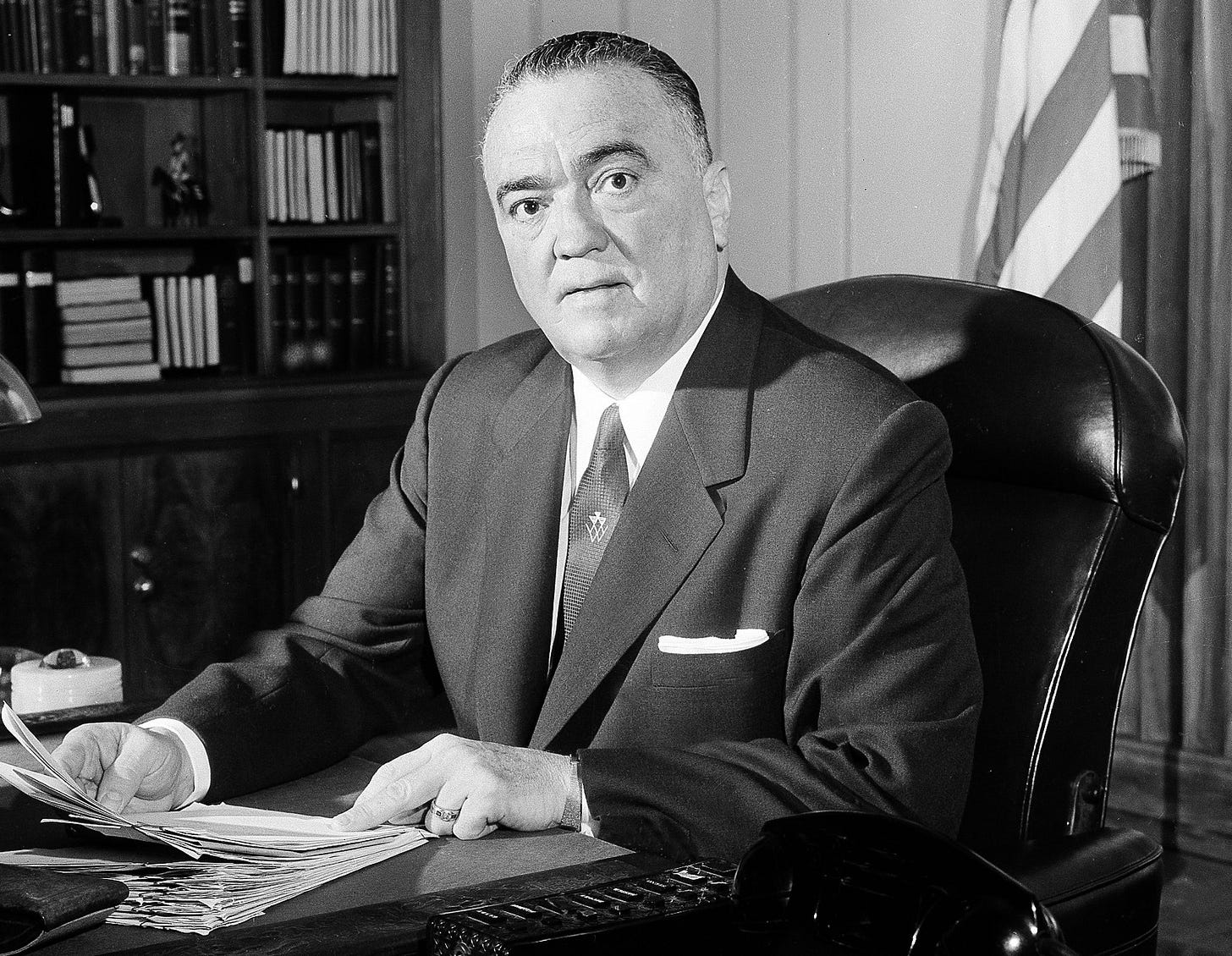The Myth of Ma Barker: Mastermind or J. Edgar Hoover's Greatest Lie?
The FBI painted her as a criminal genius. The gang's own leader said she couldn't plan breakfast. The truth about the Depression's most notorious mother is far stranger.
For four long hours on the morning of January 16, 1935, the lakeside quiet of Oklawaha, Florida, was shredded by the sound of machine-gun fire. When the smoke cleared and federal agents finally stormed the two-story cottage, they found the bodies of notorious kidnapper Fred Barker and his 61-year-old mother, Kate, better known to the world as “Ma.” And in that moment, a legend - or rather, two competing legends - was born.
To hear FBI Director J. Edgar Hoover tell it, his G-Men had just vanquished a criminal mastermind. The elderly woman they’d just killed was, in his words, “the most vicious, dangerous, and resourceful criminal brain of the last decade.” This was the official story, the one that would be splashed across newspapers and cemented in pop culture: Ma Barker, the monstrous matriarch who planned her sons’ bloody rampage through the Midwest.

There was just one problem. The people who actually knew Ma Barker, the men who robbed the banks and kidnapped the millionaires alongside her sons, called bullshit. Alvin Karpis, the gang’s co-leader and actual planner, famously scoffed that Ma “couldn’t plan breakfast.” In his version of the story, the fearsome matriarch was a harmless old woman, and her terrifying reputation was a complete fabrication, a cynical PR move by Hoover to justify the controversial killing of a grandmother.
So, which is it? Was Kate Barker the devil in a rocking chair, or was she J. Edgar Hoover’s most convenient scapegoat? The truth about the Depression’s most notorious mother is buried under decades of propaganda and self-serving lies, and it’s far stranger and more complicated than any legend.
The Making of a Matriarch
Long before J. Edgar Hoover gave her a public relations makeover; she was Arizona Donnie Clark, known to her family as “Arrie.” Born in 1873 in the small town of Ash Grove, Missouri, her story began not in a hail of gunfire, but in the quiet poverty of the post-Civil War rural Midwest. In 1892, she married a local man named George Barker, who, by most accounts, was a “shiftless” and ineffective husband. Together they had four sons: Herman, Lloyd, Arthur, and Fred. On the surface, it was an unremarkable start to an unremarkable life.
The family eventually moved to Tulsa, Oklahoma, and it was there that the veneer of simple country life began to crack. One by one, the Barker boys slid into a life of crime, starting with petty theft and escalating to highway robbery and murder. And through it all, Arrie developed the one trait that would come to define her: a fierce, almost pathological refusal to see any fault in her sons. Neighbors and lawmen who came with complaints were met not with shame, but with furious denials. While Hoover’s FBI would later sensationalize her home as an “academy of crime,” the reality was something less calculated and perhaps more tragic: a mother so blindly devoted that she became the ultimate enabler.

The breaking point for the family came in 1927. In August, her eldest son, Herman, shot and killed a police officer in Wichita, Kansas, before turning the gun on himself to avoid capture. The violent death of her firstborn reportedly had a “profound impact” on Kate. With his other three sons in jail or on their way, George Barker had finally had enough. He packed his bags and walked out, leaving Arrie alone. By 1928, the future matriarch of America’s most wanted gang was living in a dirt-floor shack in “miserable poverty,” her family destroyed and her sons locked away. But one of those sons, Fred, was about to meet a man in prison who would change everything.
The Mother of All Gangs
Kate Barker’s fortunes changed dramatically in 1931. Her youngest and favorite son, Fred, was released from the Kansas State Penitentiary, and he didn’t come home alone. He brought with him a new partner, a sharp, cold-blooded criminal named Alvin Karpis, whom he’d met on the inside. Together, they were the engine of the newly formed Barker-Karpis Gang: Karpis was the strategic brains, Fred the “natural born killer.” The destitute, lonely life of “Arrie” Barker was over. On the run with a crew of wanted men, she needed a new identity. The historical record is hazy on exactly when it began, but she started going by a simple, unremarkable alias: Kate.
This is where the legend of the criminal mastermind should have started, with Kate directing her boys from the shadows. But the reality, according to the gang’s leader, was far more mundane. Her job wasn’t to plan the crimes; it was to provide the camouflage. With an elderly mother in the passenger seat, a car full of heavily armed men looked less like a murder squad and more like a family on a road trip. As Karpis later explained, “When we traveled together, we moved as a mother and her sons. What could look more innocent?”. They would rent houses in her name, and when they needed to talk business, they’d often send her to the movies to get her out of the way. She was the perfect cover.

But this was no innocent family vacation. The gang quickly escalated their operations, and Ma was along for the ride. On December 19, 1931, Fred and Karpis shot and killed Sheriff C. Roy Kelly during a robbery in West Plains, Missouri, instantly making them wanted murderers. Her complicity was put to an even darker test with the murder of her own lover, Arthur Dunlop. The gang considered the hard-drinking Dunlop a liability who talked too much. Their solution was simple: they put a single bullet in the back of his head and dumped his body near Webster, Wisconsin. Kate, having just lost her companion to her son’s crew, didn’t flee or go to the police. She stayed with the gang, a chilling testament to where her loyalties truly lay.
For a time, this brutal operation ran smoothly, thanks in large part to the institutional corruption of St. Paul, Minnesota. Under Police Chief Thomas “Big Tom” Brown, the city operated as a “safe haven” for notorious criminals. As long as gangs like the Barker-Karpis crew didn’t commit crimes within city limits and paid the right people, they could use St. Paul as a secure base to plan their high-stakes robberies and kidnappings. Protected by the law itself, the gang was about to embark on its most audacious and, ultimately, fatal crime spree.
One Kidnapping Too Many
Fresh off the successful $100,000 kidnapping of brewer William Hamm, the Barker-Karpis gang felt untouchable. Operating from the safety of their corrupt sanctuary in St. Paul, they set their sights on an even bigger score. On January 17, 1934, they snatched another local banker, Edward Bremer, Jr., successfully extorting a staggering $200,000 in ransom. It was their most audacious crime, and it would be their last. What the gang didn’t realize was that Bremer’s father was a personal friend of President Franklin D. Roosevelt. Almost overnight, the gang went from a regional headache to a top priority for J. Edgar Hoover’s expanding Bureau of Investigation. The full weight of the federal government was about to come crashing down on them.
The intensified investigation yielded the breakthrough Hoover’s agents were looking for. It wasn’t a snitch or a lucky break, but a single, careless fingerprint left by Arthur “Doc” Barker on a gas can used during the kidnapping. This one piece of forensic evidence, a product of the Bureau’s new scientific focus, led investigators directly to Doc’s hideout in Chicago. On January 8, 1935, agents arrested him without incident. A search of his apartment turned up the next crucial link in the chain: a map of Florida with the area around Lake Weir clearly circled.

The map got the FBI to the right lake, but the final, bizarre clue that led them to the exact house came from the gang itself. In a letter sent to Doc that the FBI intercepted, a reference was made to a large, well-known local alligator nicknamed “Gater Joe.” By simply driving to Oklawaha and asking the locals where to find this specific gater, federal agents were pointed directly to the waterfront rental property where Ma and Fred were hiding under the alias “Blackburn.”
At dawn on January 16, 1935, a team of G-Men surrounded the cottage. After a call to surrender was met with defiance, the shooting started. For four excruciating hours, the agents poured a relentless stream of machine-gun and rifle fire into the house. When a sudden silence finally fell, they cautiously entered the home. Upstairs, they found the bodies of Fred Barker and his mother, Kate, surrounded by a small arsenal of firearms. The hunt was over. Now, the myth-making could begin.
Anatomy of a Legend
With the bodies of a notorious killer and his 61-year-old mother cooling in a Florida cottage, J. Edgar Hoover didn’t just have a law enforcement victory; he had a potential public relations disaster. The image of his G-Men gunning down a grandmother, no matter her connections, could have soured the heroic narrative he had so carefully constructed for his agency. His response was a masterclass in propaganda, a textbook execution of the same “War on Crime” media strategy he’d been perfecting for years.
This campaign required a steady supply of larger-than-life villains, and Hoover’s rhetoric often painted them as inhuman “vermin” that needed to be exterminated. Kate Barker, a relatively minor figure, was about to get a posthumous promotion. Hoover’s public declaration that she was the “most vicious… criminal brain of the last decade” was the opening shot. The story was then buttressed by carefully selected details from the shootout - a defiant shout from an upstairs window, a Thompson submachine gun supposedly clutched in her hands - that painted her not as a cornered old woman but as a hardened gangster who went down fighting. This wasn’t just an account of events; it was a story crafted to fit the heroic G-Man brand, a brand Hoover actively promoted through friendly writers and Hollywood studios. The Ma Barker myth wasn’t born from facts; it was manufactured to meet a need.

The unvarnished reality, known only to the criminals who survived her, was far less cinematic. The gang’s actual leader, Alvin Karpis, insisted that Kate’s involvement was a world away from Hoover’s portrayal. He and others have consistently maintained that she was deliberately excluded from the planning stages of their crimes. In a detail that speaks volumes, Karpis noted they would often send her to the movies to get her out of the house while they discussed robberies or kidnappings. This paints a picture not of a criminal mastermind, but of a woman who, at best, was a glorified housesitter.
Ultimately, the most compelling evidence against the myth is the complete lack of it. In the thousands of pages of the FBI’s files, there exists no independent, primary-source evidence - no letters, no plans, no third-party testimony - that shows Ma Barker planning or directing a single crime. Every available firsthand account from inside the criminal enterprise, including that of notorious bank robber Harvey Bailey, denies she had any leadership role. Decades later, the FBI has quietly conceded the point. Their own official website now states she was “not as the criminal mastermind later media legend made her out to be,” a quiet but definitive retreat from the powerful fiction their director created.
The Accomplice in the Rocking Chair
So, who was the real woman buried beneath a half-century of FBI headlines and self-serving gangster denials? The evidence is clear: the criminal mastermind was a ghost, a convenient fiction crafted by J. Edgar Hoover to turn a potentially messy shootout into a public relations triumph. Kate Barker never planned a robbery, cased a bank, or led a kidnapping.
But to debunk the myth isn’t to exonerate the woman. The claim that she was just an innocent old woman who loved her sons is as false as Hoover’s claim that she was a criminal genius. For years, she knowingly harbored and traveled with a gang of wanted murderers. She actively participated in their fugitive lifestyle by using aliases, helping to rent their hideouts, and living lavishly on the proceeds of their violent crimes. This wasn’t a passive role; her “cover” as a harmless mother was an indispensable logistical function that directly enabled the gang to operate.
By any legal or moral definition, that makes her a deeply culpable accomplice. The most accurate historical title for her isn’t “architect” but “enabler” - a matriarch who chose to facilitate her sons’ monstrosities rather than stop them. J. Edgar Hoover lied about the role she played, but he wasn’t wrong that she was a legitimate public enemy. Her legend is a fabrication, but her guilt was all too real.
References
Burrough, B. (2004). Public Enemies: America's Greatest Crime Wave and the Birth of the FBI, 1933-34. Penguin Press.
City of Ash Grove, Missouri. (n.d.). History. Retrieved August 20, 2025, from https://www.ashgrovemo.gov/history
Dill, E. (n.d.). Barker-Karpis Gang. MNopedia, Minnesota Historical Society. Retrieved August 20, 2025, from https://www.mnhs.org/mnopedia/search/index/group/barker-karpis-gang
Enss, C. (n.d.). An Excerpt from Ma Barker: America's Most Wanted Mother. Chris Enss. Retrieved August 20, 2025, from https://chrisenss.com/an-excerpt-from-ma-barker-americas-most-wanted-mother/
Federal Bureau of Investigation. (n.d.). Barker/Karpis Gang. FBI Records: The Vault. Retrieved August 20, 2025, from https://vault.fbi.gov/barker-karpis-gang
Federal Bureau of Investigation. (n.d.). Famous Cases & Criminals: Barker/Karpis Gang. Retrieved August 20, 2025, from https://www.fbi.gov/history/famous-cases/barker-karpis-gang
Florida Sheriffs Association. (n.d.). The Longest Shootout. Florida Sheriffs Association Blog. Retrieved August 20, 2025, from https://flsheriffs.org/blog/entry/the-longest-shootout/
Frethem, D., & Smith, C. S. (2021). Alvin Karpis and the Barker Gang in Minnesota. The History Press.
Gentry, C. (1991). J. Edgar Hoover: The Man and the Secrets. W. W. Norton & Company.
Internet Archive. (n.d.). Ma Barker FBI Files - Karpis-Barker Gang. Retrieved August 20, 2025, from https://archive.org/details/MaBarkerFbiFiles-Karpis-barkerGang
Jones, W. D. (1934). Riding with the Barrow Gang. The Dallas Morning News.
Karpis, A. (1971). The Alvin Karpis Story. Coward, McCann & Geoghegan.
Karpis, A., & Livesey, R. (1980). On the rock: Twenty-five years in Alcatraz. Beaufort Books.
Ma Barker House. (n.d.). The Gang. Retrieved August 20, 2025, from https://mabarkerhouse.org/the-gang/
Mahoney, T. (2013). Secret Partners: Big Tom Brown and the Barker Gang. Minnesota Historical Society Press.
Marquart, C. W. (n.d.). Alvin Karpis. Emporia State University.
Oklahoma Historical Society. (n.d.). Barker, Arizona Donnie Clark (1873-1935). The Encyclopedia of Oklahoma History and Culture. Retrieved August 20, 2025, from https://www.okhistory.org/publications/enc/entry.php?entry=BA026
Parkinson, J. (2024, January 17). Criminal Neighbors: Ma Barker's Gang Made West St. Paul Home. West St. Paul Reader. Retrieved August 20, 2025, from https://weststpaulreader.com/2024/01/17/ma-barker-gang-west-st-paul/
PBS. (n.d.). Depression-Era Desperadoes. American Experience. Retrieved August 20, 2025, from https://www.pbs.org/wgbh/americanexperience/features/dillinger-depression-era-desperadoes/
PBS. (n.d.). J. Edgar Hoover. American Experience. Retrieved August 20, 2025, from https://www.pbs.org/wgbh/americanexperience/features/eleanor-hoover/
Potter, C. B. (2018, February 9). The Truth About J. Edgar Hoover's "Cross-Dressing". JSTOR Daily. Retrieved August 20, 2025, from https://daily.jstor.org/the-truth-about-j-edgar-hoovers-cross-dressing/
Powers, R. G. (1983). J. Edgar Hoover and the Detective Hero. Journal of Popular Culture, 9(2), 257-278.
Smith, W. D. (2016). The Barker-Karpis Gang: An American Crime Family. W.D. Smith.
St. Paul Daily News. (1935, January 17). BULLET-RIDDLED BODIES OF MA BARKER, SON FRED, FOUND IN FLORIDA HOUSE.
TIME Magazine. (1949, March 21). CRIME: The Last of the Barkers.
Underhill, S. M. (2012). J. Edgar Hoover and the Rhetorical Rise of the FBI: The Public Campaigns Against Vermin, The Fifth Column, and Red Fascism. CORE. https://core.ac.uk/download/56110363.pdf
United States Postal Inspection Service. (2023). Kate "Ma" Barker. Retrieved August 20, 2025, from https://www.uspis.gov/history-spotlight-2023/kate-ma-barker

